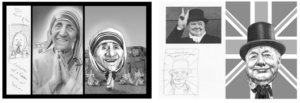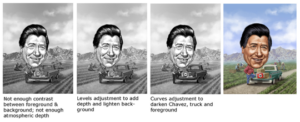Nancy Harrison, BFA, MA says, “I began my career as an illustrator like many do – crayoning on walls. Back then it was considered a bad habit, now I get paid for it. In fact, I’ve somehow managed to doodle my way into a great career.” Last week, her latest book project, Who are the Rolling Stones? went on sale at #2 on the New York Times best-seller list. We are delighted she teaches Digital Painting in the Digital Arts & Animation program at USV. We asked her to share tips from her experience…
Nancy: For the past 15 years, I’ve been making book cover art for the NYTimes best-selling “Who Was/Is…” book series with Grosset and Dunlap (Penguin Publishing). That’s a LOT of bobbleheads. I use the term endearingly, but it does get old after illustrating and making the first 100 book covers. Or maybe 20. And I’ve now completed about 150 book covers. I will probably die while painting a bobblehead – hopefully, in the far distant future. (Incidentally, I DO paint lots of other things and projects, like dragons). I thought I’d share some nuggets of wisdom I’ve picked up along the way on how to make book covers that sell…
Tips on How to Make Book Covers
First, have a contract before making a book cover. When you work with huge publishers, they ALWAYS insist on using their own boilerplate version. That does NOT mean you can’t add changes, which their legal department hates. I try to include a clause about how many book cover revisions I’m willing to make, and that I have the right to use the work to promote myself; more often than not, publishers now will want to own ALL THE RIGHTS, “in all media, now, or to be invented.” My publisher neglected this tiny detail and purchased the BOOK rights globally, then had to buy back ten years of art rights, for Apps and games and whatever else they’ve dreamed up. Ka-ching for me. : ))
Sometimes the art director will provide some written direction or nifty sketches to show me what they want…

Always ask for a written description, because the sketches might not be awesome: those blobs are moms & babies?! (Those are MY sketches on the right). If their book cover ideas suck, draw them anyway, then sneak in an idea of yours that you think might work better. Always give the client what they ask for, then deliver more. Usually, I give this client 3-5 book cover options, which they can mix-and-match heads, body positions, and backgrounds. Since they decide “by committee” of editors, art directors, publisher, executives, writers, pets… it takes ages for them to collect the comments on the book cover. I have found adding more detail than usual to the sketches actually saves ME time on doing extra revisions, and they actually use the sketches in their internal launch materials. Naturally, how much you work on sketches will depend on deadlines, and budget.

When making a good book cover, I want a strong focal point that grabs attention. You only have a few seconds to catch someone’s eye! In this case, it’s obvious that the person needs to stand out from the background, and/or foreground. They need to pop. That means paying attention to VALUES, so there’s enough contrast from the background. When I skipped the value stage, my book cover art didn’t work as well. There are other contrasts you can use to help make the focal point pop (like warm/cool, saturated/desaturated colors), but value is so fundamental. I practice what I preach.

While my client might supply a description of what they want included, it’s usually up to me to design the book art. I need to consider where the title and text will go to allow space, and minimize the contrast changes behind the title. I also like to challenge myself creatively with something – often lighting, adding sunsets, or painting something I haven’t done previously. Since these are kid’s books, bright colors usually work better. I’m still experimenting with how to incorporate bright colors, even when it’s a dark/night scene.
What happens when you REALLY HATE the published book cover art?
Sometimes clients want 10 pounds of s**t in a 5-pound bag. Actually, this happens a lot. Sigh. Grouping objects to form a cluster can help. And sometimes you have just give them what they want and cringe –
the client is always right. Kinda. There are some battles you can’t win. I’ve learned to accept I won’t love (or sometimes even like) all the book cover art I publish. Unfortunately, the public who sees the art doesn’t know the backstory: how tight the time was (due the next day), a non-existent budget (what can you do for $500….? How about a sketch on a napkin), or the client insisting I use THEIR kid as a model… Do the best you can, and move on.
As artists, we’re cursed with seeing every “flaw” in our own art. I only hope it takes 6 months instead of 6 days before I notice.


